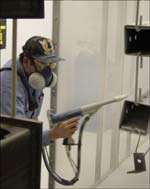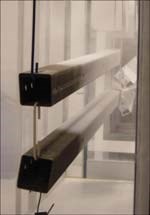PorterCorp Adds Color to the Great Outdoors
Outdoor shelters sport colorful canopies with weather-resistant, powder-coated finishes…
Founded in 1964 by William Porter, and located in Holland, MI, just east of great Lake Michigan, PorterCorp Corp. has been manufacturing outdoor shelters since 1976. Employing more than 90 people at its Holland facility, the company is very well known for its Poligon® brand shelters with tubular steel frames and metal, pine or structural insulated panels that form roof decks. Poligon shelters, gazebos, pavilions and pergolas can be seen just about anywhere offering protection from the rain or hot sun, in picnic areas, town centers and architectural building entranceways.
PorterCorp's Parasol brand outdoor shelters, with colorful textile canopies, are used to shelter playground equipment, bus stops, outdoor classrooms and walkways. Both Poligon and Parasol brands use structural steel tubing for support as well as eye-catching design elements.
Featured Content
PorterCorp understands the benefits of a powder-coated product. With constant exposure to the elements, its shelters must withstand harsh weather conditions year round. That means an attractive, long-lasting finish that doesn't crack, peel or fade. Prior to bringing powder-coating capabilities in-house, PorterCorp outsourced the process for its structural steel supports and other metal fabrications to a local custom coater.
"The whole project actually started three years earlier, but we became really serious about powder a year ago," says Don Mulder, vice president of operations, "when we decided dependability and reliability with fast color change was not only what we wanted—but needed. And we shopped around until we knew we had a good gun and booth."
PorterCorp invested in a Nordson® Econo-Coat® RCM II series powder spray booth with clear co-polymer canopy, two Sure Coat® manual spray guns with controllers and an AeroCharge® manual spray gun with alternative-charging technology. "Adding this powder system fit into our lean philosophy, especially because it supports quick color changes."
With one reclaim module and one non-reclaim module, PorterCorp has become very efficient at the color-change process. "Depending on the product we're coating on a particular day, we do up to five to six color changes per shift," Mulder says. "If we have to go in and clean the booth, it takes about 10 minutes. If we're not reclaiming and don't have to clean the booth, it takes about two to three minutes—and we're getting better at it all the time."
Pointing to a long piece of structural steel attached to winding decorative steel that looks similar to rod iron, Mulder credits the addition of the manual spray gun as another key advantage for PorterCorp. "It [AeroCharge] takes to task these difficult-to-coat, faraday-cage areas, coating deep and narrow cavities more efficiently than a corona-charging gun."
The specialized line was made to handle large stock. It will accommodate parts up to 50-feet long and weighing as much as 1,200 lbs. This has given PorterCorp the added capability of taking on contract work for coating big pieces.
With 27 standard colors and numerous custom colors, PorterCorp is very conscious of the economic and performance benefits of powder coating. In fact, the biggest advantages of bringing powder-coating capabilities in-house were an 18-month ROI on the system and more than 35% savings in powder coating costs.
In addition, PorterCorp has realized a reduction in lead times an average of two weeks or more than 30%. "By reducing our lead times, we've been able to capture more market share by better servicing our customers and providing a more predictable delivery date.
"Although powder coating was only one part of the equation," Mulder continues, "we went from having more than 100 late orders to only two late orders over a six-week period—while shipments increased more than 20%."
Currently, PorterCorp offers four product finishes:
- Powder-coated finish with surface pretreatment including shot blast and heated phosphate wash.
- Powder-coated finish with surface pretreatment including shot blast, heated alkali spray wash and electrocoat.
- Powder-coated primer with surface pretreatment including shot blast and heated phosphate wash.
- Hot dip galvanizing.
PorterCorp strives to supply customers with a premium quality product from the variety of powder-coated finishes and numerous colors it offers. For example, the primer coat finish is targeted at hands-on, do-it-yourselfers who prefer to ‘field paint' their own color coat. "Previously, we used liquid paint for our primer-coated product," Mulder comments. "While the cost of wet paint prime was less, the customer didn't get as nice a finish. It just doesn't compare to the powder finish we're getting now—it's the difference between night and day."
PorterCorp also holds very high values for its employees as well as suppliers. And it's clearly evident with the company's lean manufacturing philosophy. Gary Pendergrass, Jr., PorterCorp's powder coat shop supervisor explains, "With lean, we developed some efficiencies that could have meant layoffs. However, we told employees when the powder system was installed, they might get shuffled around—but there would be jobs for them."
Pendergrass credits each member of the team involved in making PorterCorp's powder-coating operation successful, including Quality Specialists Tim Doyle and Eric Pelak. "We went from no knowledge of powder processes a year ago to implementing a system with great success.
"The support we got from Nordson fit right in. They came in and became part of the team as far as working with our other suppliers," Pendergrass explains. "You have to look at the Nordson booth as only part of the total system—and it all has to fit. And it fit very well with Midwest Finishing's (provider of the oven, washer and conveyor) philosophy, as well as with our powder supplier, Environmental Coatings, as well as our pretreatment chemical supplier, Broadmore Products. Everybody worked well together."
RELATED CONTENT
-
Curing Oven Basics
Simply heating up the substrate does not cure the coating. There are many variables to consider when choosing the best cure oven for your application...
-
Removing Cured Powder Coatings
Question: What methods are available for removing cured powder coatings, and what are the pros and cons of these methods?
-
Touch-up Options for Powder Coated Parts
Is it true that powder coating cannot be touched up? Powder coating expert Rodger Talbert offers options for powder coating touch-ups.






















